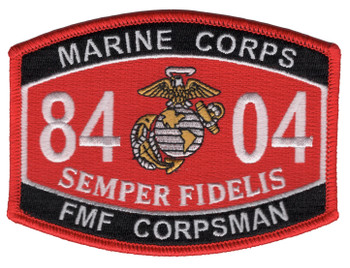Description
Navy Fleet Marine Force (FMF) Corpsman Patch 3.25" x 4.5" Embroidered Patch with Iron-On Backing
Superior Materials: Made with premium polyester thread and durable twill fabric, ensuring long-lasting color and strength.
Advanced Embroidery Technology: Crafted using the most advanced embroidery machinery, guaranteeing intricate detail, sharp lines, and consistent quality every time.
Easy Iron-On Application: Features a heat-activated adhesive backing for quick, no-sew attachment. Simply position, iron, and press for a secure bond.
Versatile Use: Perfect for personalizing jackets, backpacks, uniforms, or any fabric surface that needs a touch of personality.
Durable and Washable: Designed to withstand everyday wear and occasional washing without fading or fraying.
Formations & Origins
The Fleet Marine Force (FMF) Corpsman is one of the most revered roles in U.S. military history—a Navy medical specialist assigned to the front lines with the United States Marine Corps. The tradition dates back to World War II, when the Navy recognized the need for dedicated medical support embedded directly with Marine infantry units. Thus, Navy Hospital Corpsmen were trained in combat medicine and integrated into Marine Corps operational units, becoming essential to the survival of wounded Marines in combat.
Earning the FMF qualification means a Corpsman has not only mastered advanced medical training but also learned Marine Corps tactics, weapons, customs, and courtesies. It is a unique fusion of sailor and Marine—a warfighter with a medical kit and a rifle, trained to stabilize the wounded under fire and stand shoulder-to-shoulder with infantry in the thick of battle.
Notable Commanders
Fleet Marine Force Corpsmen do not operate under independent command but serve under Marine Corps leadership while remaining within the Navy medical chain. However, they have been led and mentored by legendary figures. Admiral Forrest Faison, a Navy surgeon general, emphasized the irreplaceable role of FMF Corpsmen in expeditionary combat. On the ground, Marine commanders like General James Mattis and General John Kelly consistently praised their Corpsmen, often calling them the most valued members of any platoon.
Though not officers in the traditional sense, senior enlisted Hospital Corpsmen, like Master Chief Petty Officer Donald A. Myrick, have led generations of field medics and influenced the combat medical doctrine that guides FMF units to this day.
Major Campaigns/Operations
FMF Corpsmen have deployed alongside Marines in nearly every conflict since World War II. They fought in the blood-soaked jungles of the Pacific, from Guadalcanal to Iwo Jima, where Corpsmen like John Bradley, one of the flag raisers at Mount Suribachi, tended to the wounded amid machine gun fire.
In Korea, they were the angels of the Chosin Reservoir. In Vietnam, they worked through thick jungle and brutal ambushes, often being the first to crawl toward the wounded. In Fallujah and Ramadi, in the heat and chaos of house-to-house combat, they braved IEDs, sniper fire, and urban warfare to save lives. And in Afghanistan, from the Korengal Valley to Helmand Province, FMF Corpsmen operated alongside Marine units in some of the most remote and dangerous outposts in the world.
Specialized Role/Equipment
An FMF Corpsman is both a healer and a fighter. They carry not only their standard issue weapon but also an extensive field medical kit, including tourniquets, gauze, chest seals, IVs, and trauma gear designed for immediate use under fire. FMF training includes Tactical Combat Casualty Care (TCCC), Marine Corps infantry tactics, land navigation, and weapons handling.
To earn the FMF pin, a Corpsman must pass a rigorous board, demonstrate full integration into Marine culture, and qualify across medical and combat competencies. Once pinned, they wear the FMF insignia—a proud badge of grit and brotherhood.
Acts of Heroism
FMF Corpsmen have earned dozens of Navy Crosses, hundreds of Silver Stars, and over 20 Medals of Honor. Their courage is often spoken in whispers and with reverence in Marine circles.
Hospitalman Donald E. Ballard earned the Medal of Honor in Vietnam when he threw himself on a grenade to shield his wounded comrades—only to survive when the grenade failed to detonate. He calmly returned to treating the wounded.
Pharmacist’s Mate William David Halyburton Jr. received the Medal of Honor posthumously for shielding a Marine with his body while treating him during the Battle of Okinawa, sacrificing his life so another could live.
Stories like theirs are countless. It’s said that every Marine remembers their Corpsman’s name, because when things go bad, they’re the first voice you hear and the last hand to leave your shoulder.
Legacy & Notable Achievements
The FMF Corpsman is not just a job—it’s a brotherhood, a calling, and a symbol of everything honorable in military service. They embody selflessness, courage, and quiet strength. Their presence in Marine units builds trust and morale, and their legacy is etched into memorials, battlefield lore, and the hearts of those they’ve saved.
Today, FMF Corpsmen continue to train with elite units, serve on the front lines, and deploy around the globe. They represent the unique bond between the Navy and Marine Corps—two branches, one fight.
To wear the FMF patch is to honor a legacy of lifesaving under fire. It tells the world that you were there—not just watching history, but shaping it, one life at a time. Semper Fi, Doc.






